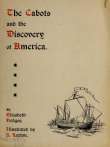قراءة كتاب The Cabots and the Discovery of America With a Brief Description and History of Brandon Hill, The Site of the Cabot Memorial Tower
تنويه: تعرض هنا نبذة من اول ١٠ صفحات فقط من الكتاب الالكتروني، لقراءة الكتاب كاملا اضغط على الزر “اشتر الآن"

The Cabots and the Discovery of America With a Brief Description and History of Brandon Hill, The Site of the Cabot Memorial Tower
retains—the famous "rib of the Dun Cow" (cow-whale) preserved with religious care in Redcliffe Church; the following interesting reference to which was discovered in recent times among the City records. "1497—Item. Paid for settynge upp ye bone of ye bigge fyshe and... (writing illegible) hys worke brote over seas, vid. For two rings of iron iiijd."
According to Socino, who wrote on Dec. 18th of this same year, Cabot recorded his discoveries on a map and also on a globe; but no trace of either has been found, although La Cosa must have had access to them for his map.
In the following year, 1498, the King granted a supplementary charter in the name of John Cabot only, authorising him to take out six ships to the "lande and isles of late founde by the said John," at his own cost, to trade and colonize; giving him for the latter purpose "300 prisoners"—doubtless glad enough to be rid of them, the gaols being full to overflowing just then in consequence of Perkin Warbeck's rebellion. Bounties were also allowed to "James Carter, Thos. Bradley, and Lancelot Thirkill, of Bristowe" for fitting out three of the ships.
The expedition sailed, made further discoveries, and returned; but whether it was under the control of John Cabot is not known, for here all record of the elder Cabot ceases.

Original
Sebastian says his father died about this time, but he gives neither date or place of burial. It seems most probable that John Cabot's death occurred at sea, and that Sebastian, who—though this has been contested—accompanied him on this voyage, returned in command. Strangely enough, no account of the expedition appears to exist among English records; the sole fact of its return being gathered from the presence in London of Lancelot Thirkill, June 6, 1501, and his repayment of the loan he had had of the King. From foreign sources, however, we know that it was John Cabot's intention in this expedition to follow the shore from his former discovery till he reached the equinoctial regions; and we also know that (whether under his command or that of Sebastian) the plan was pursued until lack of provisions compelled its abandonment.
The second expedition, taking a more northerly course than the first, visited Iceland, and then steering west, made the coast of Labrador, named by Cabot "De la Terra de los Baccalaos," "The Land of the Cod-fish," from the immense shoals of those fish which they encountered. Landing the colonists, though whereabouts in that inhospitable region is not stated, they sailed still farther to the north-west—through Hudson's Straits—until "affrighted by the monstrous heaps of ice swimming in the sea, and the continual daylight," they dared go no further.

Original
Retracing their course they found many of the colonists dead of cold and hunger, and re-embarking the remainder, they sailed south as far as Cape Hatteras, when provisions failing, the little flotilla returned to England—Unsuccessful, the merchants who had freighted the vessels deemed, for they had not found the golden goal of Cathay nor even established a trading colony! But in reality successful beyond the wildest dreams of King or people, for there is no doubt that the Cabot charter and the voyages made pursuant to it, were always regarded as the root of England's title to her American possessions, and that, "to the daring and genius of Cabot is owing the occupation of the northern continent by an


